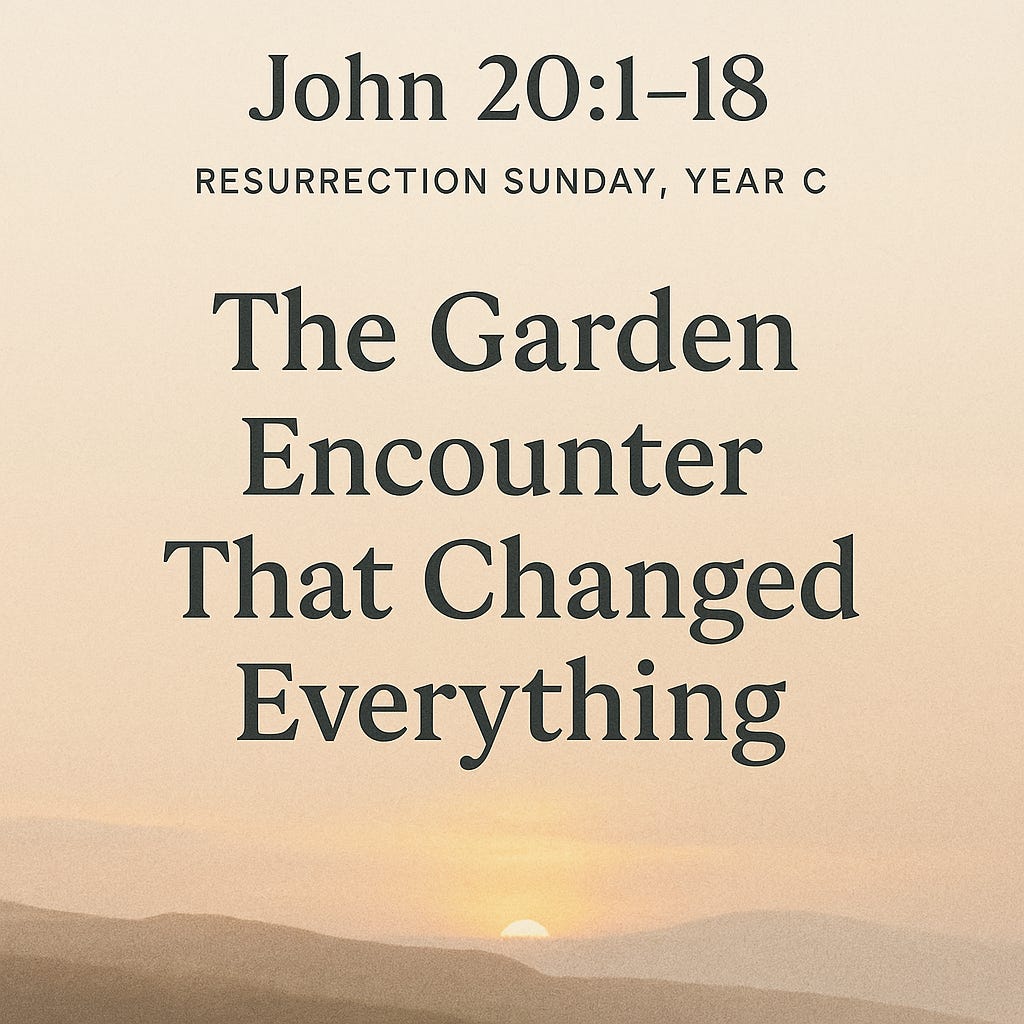The Garden Encounter That Changed Everything
John 20:1-18
Resurrection Sunday, Year C
What if resurrection comes not with fanfare, but through a name gently spoken?
In today’s Gospel reading, Mary Magdalene arrives while it’s still dark. The stone is moved. The body is gone. And yet, hope is not.
Jesus meets her not with thunder but with tenderness—calling her by name.
Context: Setting the Scene
John’s resurrection narrative stands apart. It’s intimate, poetic, and rich with layered meaning—written to invite transformation, not just information.
🕯️ Literary Context:
This moment is the narrative climax of John’s Gospel. The Word who was “with God in the beginning” now stands in a garden of new creation.
Unlike the Synoptics, John places Mary Magdalene alone at the tomb, emphasizing her role as both seeker and first witness.
The mistaken identity—Jesus as the gardener—is not a blunder. It’s theological gold. Just as Adam tended the garden, Jesus, the New Adam, tends to the brokenness of humanity.
John uses irony, symbolism, and echoes of earlier passages (John 10: “My sheep know my voice”) to show that recognition in resurrection comes through relationship.
🌍 Historical Context:
For a woman to be the first witness to the resurrection was radical. In a culture where women’s testimony was considered invalid, Jesus places Mary at the center of the Easter story.
The description of the linen wrappings, spices (from John 19), and folded face cloth reveal cultural burial practices—and indicate that this was no grave robbery.
The early-morning darkness represents more than time—it embodies grief, confusion, and unknowing. And yet, this is where resurrection begins.
John 20:1-18 (NLT)
Early in the morning of the first day of the week, while it was still dark, Mary Magdalene came to the tomb and saw that the stone had been taken away from the tomb. 2 She ran to Simon Peter and the other disciple, the one whom Jesus loved, and said, “They have taken the Lord from the tomb, and we don’t know where they’ve put him.” 3 Peter and the other disciple left to go to the tomb. 4 They were running together, but the other disciple ran faster than Peter and was the first to arrive at the tomb. 5 Bending down to take a look, he saw the linen cloths lying there, but he didn’t go in. 6 Following him, Simon Peter entered the tomb and saw the linen cloths lying there. 7 He also saw the face cloth that had been on Jesus’ head. It wasn’t with the other clothes but was folded up in its own place. 8 Then the other disciple, the one who arrived at the tomb first, also went inside. He saw and believed. 9 They didn’t yet understand the scripture that Jesus must rise from the dead. 10 Then the disciples returned to the place where they were staying.
11 Mary stood outside near the tomb, crying. As she cried, she bent down to look into the tomb. 12 She saw two angels dressed in white, seated where the body of Jesus had been, one at the head and one at the foot. 13 The angels asked her, “Woman, why are you crying?”
She replied, “They have taken away my Lord, and I don’t know where they’ve put him.” 14 As soon as she had said this, she turned around and saw Jesus standing there, but she didn’t know it was Jesus.
15 Jesus said to her, “Woman, why are you crying? Who are you looking for?”
Thinking he was the gardener, she replied, “Sir, if you have carried him away, tell me where you have put him and I will get him.”
16 Jesus said to her, “Mary.”
She turned and said to him in Aramaic, “Rabbouni” (which means Teacher).
17 Jesus said to her, “Don’t hold on to me, for I haven’t yet gone up to my Father. Go to my brothers and sisters and tell them, ‘I’m going up to my Father and your Father, to my God and your God.’”
18 Mary Magdalene left and announced to the disciples, “I’ve seen the Lord.” Then she told them what he said to her.
Listen to John 20 in the Message
Key Insights
The First Witness: Mary Magdalene is chosen as the first to encounter and proclaim the resurrection—not despite her marginal status, but because of it.
“Don’t cling to me”: Jesus is calling Mary (and us) into a faith that doesn’t grasp at the past but lives into what’s being made new.
Resurrection is Recognition: She doesn’t recognize him until he says her name. The risen Jesus meets us in love, not spectacle.
Sacred Practice
Sit with this story using the ancient rhythm of Lectio Divina:
Read – Slowly read verses 11–18.
Reflect – What word or image stands out?
Respond – What is God inviting you to feel or do?
Rest – Be still. Let Love speak your name.
Jesus-Centered Questions
What does this story reveal about the heart of Jesus?
In what ways am I like Mary—grieving, confused, longing for clarity?
What old forms of faith might I be clinging to?
Who is God calling me to witness to with my own “I have seen the Lord”?
Reflections & Resources
Working Preacher Commentary on John 20:1-18
Want to Reflect Together?
Hit reply or leave a comment.
What phrase stood out to you?
Where did you feel the Spirit’s nudge?
Connect the Threads
Other Easter readings:
How do these passages intersect to reveal the Good News?
Weekly Practice Invitation
This week, pay attention to when you hear your name spoken with love. Practice seeing the Risen Christ in the ordinary, in the gardeners, in the early morning light.






